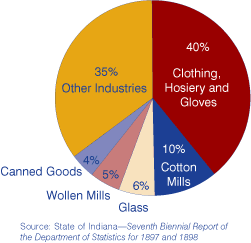Sister Carrie and Women Wage Earners in the 1890s
It's late summer in 1889, and Carrie Meeber, the 18-year-old heroine of Theodore Dreiser's fictional Sister Carrie, is wandering through Chicago's manufacturing and wholesale district trying to find work. She imagines the people working in the buildings “counting money, dressing magnificently and riding in carriages.” As she walks past windows and signs, she becomes “conscious of being gazed upon and understood for what she is—a wage-seeker.” On her seventh attempt to find work, she is finally offered a position in a shoe factory punching holes in leather for $4.50 per week (about $110 per week in 2006). She accepts though she had expected no less than $6.00 per week (about $146 in 2006). She leaves the building feeling lighter, noticing that men and women are smiling, overhearing conversation and laugher. She believes she will do well, that life is better, livelier and sprightlier.
In 1895–96, the U.S. Department of Labor surveyed 1,067 industrial establishments in 30 states in order to investigate the employment and wages of women and children compared to that of men. The survey collected data on 68,380 males and 79,987 females. The data was presented in the Eleventh Annual Report of the Commissioner of Labor entitled Work and Wages of Men, Women and Children.
It seems there were but a few manufacturing occupations available to Carrie Meeber at the time, but with some experience, she might have been offered more than $4.50 per week. According to the survey, manufacturers of leather and leather goods in Illinois were paying adult women $9.00 per week ($218) as forewomen; between $6.00 and $8.00 per week ($146 and $194) as machine operators; and between $4.00 and $7.00 per week ($97 and $170) as pasters.
How might Carrie have faired in Indiana? Another report, the Seventh Biennial Report of the Department of Statistics for 1897 and 1898, published by the Indiana Bureau of Statistics, provides greater detail about the status of working women in Indiana at the time. A survey of 1,117 establishments across 59 industries shows most women were working in cotton mills, woolen mills, and establishments that manufactured clothing, hosiery, gloves, glass and canned goods (see Figure 1).
Figure 1: Women Employment, Indiana 1898

Not surprisingly, skilled women and those with work experience were paid higher wages than were young women like Carrie Meeber (see Table 1). Highly paid occupations included forewomen in various industries, cigar-makers, machine operators (clothing, hosiery and gloves) and milliners. Occupations with the lowest average hourly wages included machine hands (metal and metallic goods), spoolers (clothing, hosiery and gloves), burnishers (metal and metallic goods), warpers (woolen mills) and piecers (cotton mills).
Table 1: Average Daily Wages for Women in Selected Industries, 1898

Published in 1888, the Fourth Annual Report of the Commissioner of Labor, entitled Working Women in Large Cities, discusses the general working conditions for Indianapolis in the mid to late 1800s.
According to the report, rents were moderate, but nine of every 10 working women of Indianapolis lived at home. There was little poverty and even the worst streets were relatively neat and desirable. Wages were low, but many girls wanted to save and they owned stock in building associations or had bank accounts. There was an ample supply of educational facilities and even though churches were numerous, few working girls were churchgoers.
Generally, the establishments were not terribly suited for industrial use. Many did not have proper fire escapes, dressing rooms or closets. Lighting and ventilation were poor. According to the report, however, “[t]he shop regulations are kind and fair, the moral tone of the workrooms respectable, and the employers, as a class, just.”
Frank Wilmot, State Data
Center Coordinator
Indiana State Library
